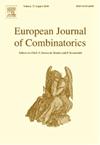无限非周期性单词的回文长度
IF 0.9
3区 数学
Q1 MATHEMATICS
引用次数: 0
摘要
有限单词v的回文长度等于串接等于v的回文的最小个数。2013年曾推测,对于每一个无限的非周期单词x,其因子的回文长度都是无界的。我们证明这个猜想是正确的。本文章由计算机程序翻译,如有差异,请以英文原文为准。
Palindromic length of infinite aperiodic words
The palindromic length of the finite word is equal to the minimal number of palindromes whose concatenation is equal to . It was conjectured in 2013 that for every infinite aperiodic word , the palindromic length of its factors is not bounded. We prove this conjecture to be true.
求助全文
通过发布文献求助,成功后即可免费获取论文全文。
去求助
来源期刊
CiteScore
2.10
自引率
10.00%
发文量
124
审稿时长
4-8 weeks
期刊介绍:
The European Journal of Combinatorics is a high standard, international, bimonthly journal of pure mathematics, specializing in theories arising from combinatorial problems. The journal is primarily open to papers dealing with mathematical structures within combinatorics and/or establishing direct links between combinatorics and other branches of mathematics and the theories of computing. The journal includes full-length research papers on important topics.

 求助内容:
求助内容: 应助结果提醒方式:
应助结果提醒方式:


